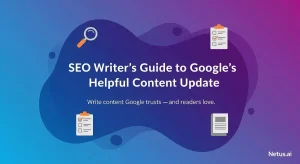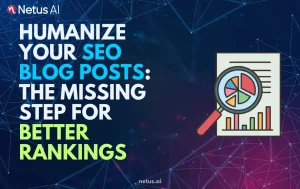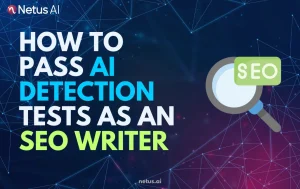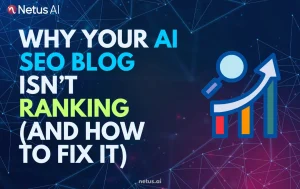
Why Google’s ‘Who, How, Why’ Framework Matters for EEAT | NetusAI
Why Google’s ‘Who, How, Why’ Framework Matters for EEAT AI can create articles in seconds. But here’s the truth: speed is not enough. Google wants
How to Bypass AI Detector: Tips and Tricks

Content writer and editor for Netus.AI
How to Bypass AI Detector. AI detectors are becoming increasingly common in today’s digital landscape, with many content platforms implementing them to ensure authenticity and originality. However, for those who rely on artificial intelligence to generate content, these detectors can pose a significant challenge. The question then arises: how can one bypass AI detectors to maintain the authenticity and originality of their content?
One way to bypass AI detectors is by humanizing the content. Injecting personal anecdotes and writing in a conversational tone can make the content more engaging and relatable, which can be a subtle sign of human authorship. AI-generated content often lacks this element of personal connection. There are also tools available, such as WriteHuman and Undetectable AI, that can help humanize the content and remove AI detection from popular platforms like Turnitin, ZeroGPT, and Writer.
Artificial intelligence (AI) detectors are algorithms that are designed to identify whether a piece of content has been generated by a machine or by a human. These detectors are used to combat the rise of automated content creation, which can lead to the proliferation of low-quality, spammy, or misleading content.
There are several types of AI detection algorithms, each with its own strengths and weaknesses. Some of the most common types of algorithms include:
AI detectors use a variety of techniques to identify generated content. Some of the most common techniques include:
In summary, AI detectors are algorithms that are designed to identify whether a piece of content has been generated by a machine or by a human. They use a variety of techniques, including pattern recognition, context analysis, and natural language processing, to identify generated content. By understanding how these detectors work, content creators can take steps to ensure that their content is not flagged as machine-generated.
As AI-generated content continues to proliferate, it is increasingly important to find ways to bypass AI detection. Here are some strategies to humanize AI content and make it more difficult for AI detectors to identify:
One of the most effective ways to bypass AI detection is to incorporate a personal touch into the writing. This can be done by adding personal anecdotes, humor, or other elements that inject a sense of “humanness” into the writing. According to Content at Scale, this can be a challenge for AI to mimic perfectly and can make the writing more engaging and relatable.
AI-generated content often lacks the element of personal connection that human-written content possesses. To bypass AI detection, it is important to diversify writing styles and tone. Simplifying the writing style can help avoid excessively long and complex sentences that sound robotic. Additionally, varying the tone of the writing can help to create a more natural and human-like feel to the content. According to Joey Geller, this can help to make the content sound more like it was written by a human and less like it was generated by AI.
Another effective way to bypass AI detection is to manually edit and review the content. This can help to catch grammatical inconsistencies and other errors that AI detectors may pick up on. According to Undetectable AI, manual editing of AI-generated content can help in evading detection. Additionally, tools like Undetectable AI can rewrite content and humanize it, ensuring that it follows natural human writing nuances.
By incorporating a human touch, diversifying writing styles and tone, and manually editing and reviewing content, it is possible to bypass AI detection and create content that sounds more like it was written by a human. While AI detectors are becoming more advanced, these strategies can help to create content that is more difficult to detect and ensure that it resonates with readers.
One of the most effective ways to bypass AI content detectors is by using AI bypassing software. These tools are designed to rewrite content in a way that makes it undetectable by AI content detectors. One such tool is Undetectable AI, which is a top-tier undetectable AI writing tool that stands out for the wide array of features it provides. It can easily bypass AI detectors like Turnitin, Winston AI, and Originality.ai using the extensive AI bypass options that are available.
Another popular tool is Bypass AI, which is an advanced AI humanizer that can consistently humanize AI text and deliver high-quality content. It uses natural language processing algorithms to rewrite content and make it sound more human-like, which can help bypass AI detection.
Paraphrasing and rewriting tools are another effective way to bypass AI content detectors. These tools work by taking existing content and rewriting it in a way that makes it unique and undetectable by AI content detectors. One such tool is QuillBot, which uses advanced algorithms to rewrite content and make it sound more natural. It can also be used to paraphrase content and make it more unique, which can help bypass AI detection.
Another popular tool is Grammarly, which is a writing assistant that can be used to check grammar, spelling, and punctuation. It also has a paraphrasing feature that can be used to rewrite content and make it more unique. While Grammarly is not specifically designed to bypass AI detection, it can still be an effective tool for rewriting content and making it undetectable by AI content detectors.
Overall, there are several tools and techniques that can be used to bypass AI content detectors. Whether you choose to use AI bypassing software or paraphrasing and rewriting tools, it’s important to choose a tool that is effective and reliable. By using these tools, you can ensure that your content is unique and undetectable by AI content detectors, which can help you avoid plagiarism and maintain the integrity of your work.
One of the biggest challenges of using AI-generated content is maintaining authenticity. While AI-generated content can be highly effective, it can also come across as robotic or formulaic. To ensure that your content feels genuine and not machine-generated, there are a few strategies you can use.
One effective way to maintain authenticity is to incorporate original research into your content. By conducting your own research and including the results in your content, you can ensure that your content is unique and not simply regurgitated information from other sources.
Original research can take many forms, including surveys, interviews, and experiments. By including your own research in your content, you can add value to your content and make it more engaging for your readers.
Another effective way to maintain authenticity is to use personal anecdotes and stories in your content. By sharing your own experiences and perspectives, you can add a personal touch to your content and make it more relatable for your readers.
Personal anecdotes and stories can take many forms, including personal narratives, case studies, and testimonials. By including personal anecdotes and stories in your content, you can create a connection with your readers and build trust with them.
Incorporating original research and using personal anecdotes and stories are just two strategies for maintaining authenticity in your content. By using these strategies and others, you can ensure that your content is unique, engaging, and authentic, even when using AI-generated content.
As AI detection methods continue to evolve, it is important to stay up-to-date with the latest techniques to bypass them. Adapting to new AI detection methods and continuously learning and updating techniques are essential to staying ahead of the game.
One effective way to stay ahead of AI detection evolution is to adapt to new AI detection methods. As AI systems become more sophisticated, they are better able to detect AI-generated content. Therefore, it is important to stay informed about the latest AI detection methods and adapt accordingly.
One way to adapt to new AI detection methods is to use language models that are not commonly used by AI algorithms. For example, using local slang or dialects that are not commonly used in AI models can help to bypass detection. Additionally, using different writing styles and structures can also help to bypass AI detection.
Another effective way to stay ahead of AI detection evolution is to continuously learn and update techniques. As AI algorithms become more sophisticated, they are better able to detect AI-generated content. Therefore, it is important to continuously learn and update techniques to bypass detection.
One way to continuously learn and update techniques is to stay informed about the latest machine learning algorithms and techniques. Additionally, regularly testing and refining techniques can help to ensure that they remain effective against evolving AI detection methods.
In conclusion, staying ahead of AI detection evolution requires adapting to new AI detection methods and continuously learning and updating techniques. By staying informed about the latest techniques and regularly testing and refining techniques, individuals can help to ensure that they are able to bypass AI detection and create effective AI-generated content.
There are several methods that can be employed to trick an AI plagiarism detector, including changing the sentence structure, replacing words with synonyms, adding or removing punctuation, and altering the order of words. However, it is important to note that these methods may not always be effective and can sometimes result in poorly written content.
One technique to pass an AI originality check is to use a combination of human-written and AI-generated content. This can help to create content that is unique and original while still incorporating the benefits of AI-generated text. Additionally, using proper citation and referencing can also help to avoid plagiarism and increase the originality of the content.
To avoid detection by AI content scanners, it is important to ensure that the content is unique and original. This can be achieved by using a combination of human-written and AI-generated content, as well as proper citation and referencing. Additionally, using natural language and avoiding repetitive phrases can also help to avoid detection by AI content scanners.
One way to circumvent AI monitoring in online examination tools is to use a combination of human-written and AI-generated content. This can help to create content that is unique and original while still incorporating the benefits of AI-generated text. Additionally, using proper citation and referencing can also help to avoid plagiarism and increase the originality of the content.
It is possible to use AI-generated content without being flagged by detection software, but it requires careful planning and execution. One approach is to use a combination of human-written and AI-generated content, as well as proper citation and referencing. Additionally, using natural language and avoiding repetitive phrases can also help to avoid detection by AI content scanners.
To prevent AI from identifying text as machine-generated, it is important to use natural language and avoid repetitive phrases. Additionally, using a combination of human-written and AI-generated content, as well as proper citation and referencing, can also help to increase the originality of the content and prevent detection by AI content scanners.

Why Google’s ‘Who, How, Why’ Framework Matters for EEAT AI can create articles in seconds. But here’s the truth: speed is not enough. Google wants

SEO Writer’s Guide to Google’s Helpful Content Update Keeping up with Google’s algorithm changes can feel like a relentless game of whack-a-mole. Just when you

Can AI Content Be Safe for SEO in 2025? Let’s start with the question of keeping every content strategist, SEO pro and blogger awake at

Humanize Your SEO Blog Posts: The Missing Step for Better Rankings You’ve done everything by the book. Your keyword research is impeccable. Your meta descriptions

How to Pass AI Detection Tests as an SEO Writer Let’s paint a familiar picture. You’ve just finished a blog post. The headline is sharp,

Why Your AI SEO Blog Isn’t Ranking (And How to Fix It) You embraced AI for your blog. The promise was intoxicating: high-quality content, published
@ 2024 Netus AI.